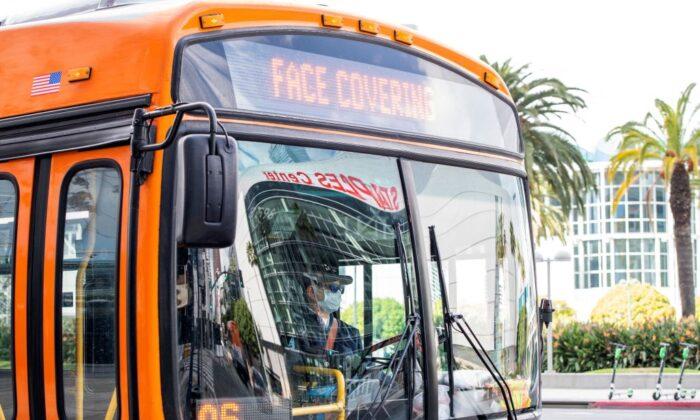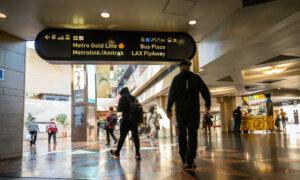LOS ANGELES—A man was fatally shot on a bus in the city of Commerce on May 16, just hours after Los Angeles Mayor Karen Bass announced an increase in law enforcement to tackle violence on the region’s embattled public transit system.
“The spike in violent crime that we have recently seen against operators and riders has been absolutely unacceptable,” Ms. Bass said during a May 16 press conference with transit officials.
Ms. Bass, who is also chair of the board for the Metropolitan Transit Authority—known as Metro—directed an “immediate surge” of law enforcement on May 15 to patrol the system’s trains, buses, and stations.
In response to the May 16 tragedy, in which a person was fatally shot in an allegedly unprovoked attack, Metro said in a statement that the incident “exemplifies how violence is increasing in society overall and spilling into our local communities.”
The crisis of violence on trains and buses in 2024 has increased pressure for public safety measures to staunch the crisis and reassure a wary public.
Ms. Bass’s call for a law enforcement surge marked an abrupt pivot. Just last month, buoyed by reports of increased ridership and decreased year-over-year crime, she insisted Metro was safe for passengers: “My message to the community is, Metro is safe,” she told reporters.
On May 16, when asked if she still felt the same, the mayor replied, “No, I do not feel the same way.”
Ms. Bass also proposed a motion that would increase the daily deployment of public safety personnel—including law enforcement, security officers, and outreach workers—by 20 percent, with a focus on “visibility,” as well as other improvements in cellular reception and interagency communications.
Metro’s proposed 2025 budget seeks a 10 percent increase over the previous year, to $194 million, for law enforcement contracts, but such won’t actually increase deployment.
The Los Angeles Police Department (LAPD), the Los Angeles County Sheriff’s Department, and the Long Beach Police Department currently share jurisdiction over the transit system.
Metro normally has more than 600 law enforcement officers in the system daily and about 200 transit security officers, according to agency officials. The surge that began on May 15 will continue to ramp up in the coming days.

Negative Public Perception
“There is no statistic that I can say that is going to overcome people’s believed perception,” Los Angeles Police Department Transit Division Deputy Chief Don Graham told The Epoch Times. “And with everything that’s been in the media lately and the stuff that you see on social media, you would think that the Metro system has become this sort of dystopia.”On a recent four-hour foot beat, that’s the last thing he saw, he said.
“I gave out stickers to little kids and I saw families riding on the metro,” Mr. Graham said. “Ambassadors were out there shaking everybody’s hand. The place looked clean.”
He said his division would do everything possible to provide personnel for the surge, and in areas where it may fall short, look for efficiencies that would keep a steady, increased presence.
For example, there may be a way to keep arresting officers on the line while a backup team transports suspects to jail facilities and handles bookings, Mr. Graham said.
In addition to law enforcement, Metro also employs private security, or unarmed “ambassadors,” who offer navigational help as well as overdose and first aid response, as well as other outreach personnel in a “multilayered” public safety strategy.
Since 2020, there has been tension between activist efforts to reduce police presence in favor of a “care-based” approach to public safety and a growing call for increased law enforcement to address the public safety crisis.
In June, the Los Angeles County Department of Mental Health will begin training ambassadors and homeless outreach workers on Metro to improve response efforts, according to Los Angeles County Supervisor Kathryn Barger.
Increasingly, public officials are acknowledging that issues related to rampant homelessness, untreated drug addiction, and mental illness account for a great deal of the transit system’s current crisis.
Both Metro CEO Stephanie Wiggins and Ms. Barger, who also sits on Metro’s board, on May 16 pointed to the broader dysfunction that spills over into the transit system.
Noting data indicating untreated mental illness as a contributing factor in many recent unprovoked attacks, Ms. Wiggins said, “Metro is a transit agency, not a social services agency.”
Ms. Barger said, “Despite the safety resources we’ve allocated, there continues to be a very real and unacceptable level of violence and a blatant disregard for the law and our code of conduct.”
“We won’t be able to arrest our way out of this problem, but law enforcement is an essential resource Metro needs so we can bring back our system,” Ms. Barger said.

Public Safety Approach
At the May 16 press conference, Ms. Bass said she didn’t see the current crisis as an indictment of the agency’s multilayered approach to public safety, noting that crime remains on a yearslong downward swing and that it comes in waves.“We want to continue our approach, but when you have a spike you respond aggressively,” she said.
In 2022, Metro removed fare and code of conduct enforcement from law enforcement agencies’ purview, shifting the responsibility to its transit security officers. That took away some ability for law enforcement to initiate criminal investigations of more serious behavior that begin with reasonable suspicion or fare evasion, Mr. Graham suggested.
Since March 2023, law enforcement has resumed the practice of checking people for fare cards, and several officials have called for increased enforcement of fare evasion and hardened entry barriers.
At Metro’s May 16 Operations Safety and Customer Service Committee meeting, several activists spoke against a planned contract to revamp the TAP, or entry card, system, calling instead for a completely free system.
“Ambassadors are the preventative measure we need to be investing in,” said Alfonso Directo, an advocacy manager with nonprofit Alliance for Community Transit–Los Angeles (ACT-LA). He said increased police presence won’t address underlying safety issues or “root causes” of the crisis, or prevent incidents.
Such claims that police don’t prevent crimes are convenient, Mr. Graham said, because there are no statistics showing how many crimes didn’t happen because the police weren’t there.
“But we know when we arrest people and run their criminal rap sheets how many times they’ve been arrested and arrested and arrested and released and released and released,” he said.
“How many times do you need us to catch this fish?”
Repeat offenders have been implicated in several of the recent high-profile attacks, including the April 22 murder.
At the May 16 committee meeting, Los Angeles City Council President and Metro Board member Paul Krekorian inquired about efforts to keep repeat offenders away from the riding public, suggesting that unlike code-of-conduct violations, those who commit violent offenses should be subject to a one-strike-you’re-out rule.
Part of the problem, board officials acknowledged, is a lack of communication among agencies. Currently, law enforcement that patrol Metro have access to a criminal database showing if someone has a stay-away order but not to an MTA court system which may have logged multiple offenses or banned someone from the system.
“There’s a lot of communication clearing up we have to do,” Mr. Graham said.
His division currently has a list of about 20 individuals who have been arrested multiple times in the past 12 months for crimes against people whom police would like to see Metro consider banning.
“If you’ve been arrested multiple times on the system, I’m not talking about multiple times in society, I’m talking about multiple times on the MTA system, then yes,” Mr. Graham said, “I certainly think that you are deserving of consideration to not be allowed to come back here again, because you’re a threat to the public.”

Crime Statistics
According Metro data, “crimes against persons”—things such as homicide, rape, and aggravated assault—have decreased precipitously by 40 percent year-to-date over the previous year. And in March, the same category fell by 19 percent.In the city of Los Angeles, violent crime is down by 48 percent on the transit system, according to the LAPD.
But that doesn’t provide the whole picture.
Total, system-wide crimes have increased in the first three months of 2024 compared to the same period in recent years (1,719 in 2024, compared to 1,034 in 2023, 833 in 2022, 565 in 2021, and 660 in 2020), according to Metro data. Much of this is owing to an increase in crimes against society, such as narcotics and trespassing.
From April 2023 to March, overall system-wide crimes increased by 78 percent over the same 12-month period in the year prior, according to Metro reports.
Ridership is also increasing, after historic lows during the COVID-19 pandemic, reaching almost 1 million riders per day in April.
Ms. Wiggins on May 16 noted that April is the 17th straight month showing year-over-year ridership increases.
“We’re not judging our success by statistics—we need a system that is not only safe but feels safe,” she said.




